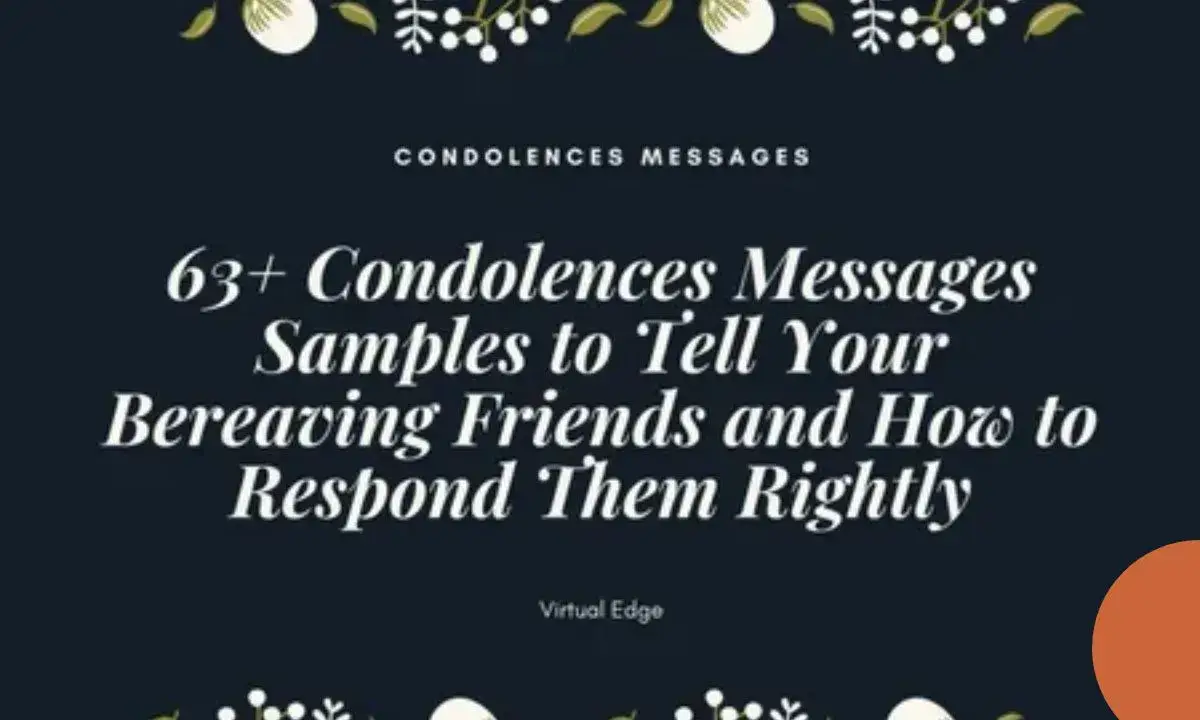When grief enters our lives, the outpouring of sympathy from others often arrives as a comforting embrace. Yet, in the midst of loss, responding to these expressions of care can feel overwhelming. This guide offers thoughtful ways to acknowledge condolences, whether they come through handwritten notes, text messages, social media posts, or in-person conversations.
It also provides 600+ examples and response templates for every situation — from formal workplace replies to heartfelt messages after the loss of a loved one.
Let’s walk through how to respond with grace, gratitude, and authenticity.
Why Responding to Condolence Messages Matters
Responding to condolence messages isn’t about social obligation — it’s about connection.
When someone reaches out during your darkest moments, their message represents compassion, empathy, and shared humanity. Responding, even briefly, acknowledges that kindness and strengthens relationships.
Emotional Significance
Expressing gratitude can aid your healing. Studies on grief psychology show that acknowledging support helps people cope better during mourning.
Social Importance
A reply reassures others that their care was received and appreciated. It keeps bonds alive — even when words feel hard to find.
Cultural Context
In some cultures, acknowledging sympathy is an essential part of bereavement etiquette. For instance, in Islamic tradition, responses like “JazakAllah khair for your prayers” express both gratitude and faith.
“Gratitude is not only the greatest of virtues but the parent of all others.” — Cicero
Understanding the Purpose of Condolence Messages
Condolences express empathy, sorrow, and solidarity. They’re not meant to fix your pain — only to let you know you’re not alone.
Types of Condolence Messages
| Type | Platform | Tone | Example |
|---|---|---|---|
| Handwritten Card | Traditional | Formal, heartfelt | “Your presence at the service meant a lot.” |
| Text Message | Digital | Short, sincere | “Thinking of you during this hard time.” |
| Social Media Comment | Public Platform | Polite, warm | “Sending love and prayers to your family.” |
| Verbal Condolence | In-person | Emotional, genuine | “I’m so sorry for your loss.” |
Understanding why people reach out helps you respond in a way that feels both natural and meaningful.
Factors to Consider Before Responding
Before sending your replies, pause for a moment. Consider these factors to ensure your response reflects sincerity:
- Emotional Readiness: If the grief is still fresh, take your time.
- Relationship Level: Tailor your tone based on closeness.
- Medium: A handwritten letter suits family; a text may suffice for colleagues.
- Cultural or Religious Sensitivity: Respect traditions — avoid assumptions.
- Privacy: Only share what you’re comfortable revealing.
“You don’t have to respond immediately. Healing takes time — so does gratitude.”
Different Ways to Respond to Condolence Messages
There’s no one-size-fits-all reply. The best way depends on who reached out, how they did, and your comfort level.
| Response Type | Best For | Tone | Example |
|---|---|---|---|
| Verbal | Close friends & family | Personal | “Your support means the world right now.” |
| Letter | Extended family, mentors | Formal | “Your note brought comfort to our family.” |
| Social Media | Public supporters | Appreciative | “Thank you all for your kind thoughts.” |
| Text/Email | Coworkers, acquaintances | Brief, polite | “I appreciate your kind message.” |
How to Respond Verbally
Responding in person often happens at funerals or gatherings. It’s emotional but powerful.
Tips:
- Maintain eye contact and keep it brief.
- Use a calm tone.
- Don’t overexplain — a few sincere words are enough.
Examples:
- “Thank you, that means so much right now.”
- “I appreciate your support — it’s comforting to hear.”
- “Your presence brings comfort. Thank you.”
Sometimes, silence and a gentle nod speak louder than words.
Writing a Thoughtful Condolence Response Letter
A handwritten note shows lasting appreciation. It’s a keepsake that honors both the sender and the departed loved one.
Structure:
- Opening: Express gratitude.
- Middle: Reference their message or gesture.
- Closing: End with warmth.
Example Template:
Dear [Name],
Your kind words after [Name]’s passing brought comfort to our family. We deeply appreciate your thoughtfulness and prayers.
With gratitude,
[Your Name]
A letter like this carries deep emotional resonance.
Responding to Condolence Messages on Social Media
Social media can feel overwhelming when condolences pour in publicly. A simple, sincere acknowledgment often works best.
Tips for Social Media Replies:
- Keep it short and inclusive.
- Thank groups collectively.
- Avoid engaging in long comment threads if it feels emotionally draining.
Examples:
- “Thank you all for your kind messages and prayers. Your support means more than you know.”
- “Your love and thoughts have brought comfort to our family.”
Privacy Tip:
If you prefer privacy, post once publicly, then disable comments or respond privately to close friends.
Responding to Condolence Messages Through Text or Email
Digital messages are common today. A short, heartfelt reply is all that’s needed.
Examples:
- “Thanks so much for thinking of us — your message truly meant a lot.”
- “I appreciate your kind words and support during this difficult time.”
- “Your email brought comfort; thank you for reaching out.”
Keep tone warm, not robotic. Avoid copy-paste phrases.
Examples of Appropriate Condolence Responses
Here are categorized examples to help you respond with ease.
By Relationship
| Relationship | Response Example |
|---|---|
| Close Friend | “Thank you for standing by me — your friendship has been my strength.” |
| Coworker | “I appreciate your understanding and kindness during this time.” |
| Neighbor | “Your gesture meant a lot. Thank you for checking in.” |
| Acquaintance | “Your kind message was very thoughtful. Thank you.” |
By Tone
- Formal: “Your condolences are deeply appreciated.”
- Informal: “Thanks so much — it really means a lot.”
- Religious: “May God bless you for your kindness and prayers.”
Managing Overwhelming Amounts of Condolence Messages
When messages flood in, it’s easy to feel emotionally drained.
Ways to Manage:
- Batch Your Responses: Thank everyone collectively.
- Delegate: A family member can help manage replies.
- Public Acknowledgment Post: A single message can cover many.
Example Post:
“We are deeply grateful for your love and support. Every message has brought comfort during this painful time.”
Remember, you’re not obligated to reply to every message immediately.
When You Don’t Feel Like Responding Right Away
Grief can silence words. That’s okay.
Tips:
- Wait until you’re emotionally ready.
- Draft short acknowledgments for later.
- Let people know you’ll respond when you can.
Example:
“Thank you for your message — I truly appreciate it. I’ll reply more when I’m able.”
Taking your time is not rude; it’s human.
Responding to Condolence Messages in a Group Setting
Sometimes condolences come from a workplace team, church group, or community.
Example Replies:
- “Thank you to everyone for the beautiful card and kind words.”
- “Your group’s support has been a great comfort to our family.”
If possible, mention a specific gesture, like flowers or meals, to personalize your response.
Balancing Gratitude with Grief
It’s okay to feel both thankful and broken. True gratitude doesn’t mean suppressing pain.
Example:
“Though my heart aches, your message brought comfort.”
According to grief counselors, expressing both grief and appreciation can accelerate emotional recovery by acknowledging dual emotions honestly.
Thank You Reply to Condolence Message on Death
Here are short, universal examples you can use:
- “Your condolences mean more than I can express.”
- “I’m grateful for your words and prayers.”
- “Thank you for remembering [Name] with such kindness.”
Acknowledge the sentiment, not just the message.
How to Respond to Condolences Messages
Here’s a quick four-step guide:
- Acknowledge the sender’s kindness.
- Express Gratitude genuinely.
- Personalize if possible.
- Close warmly.
Example:
“Thank you for your comforting words. Your message reminded me that I’m not alone.”
Simple. Honest. Heartfelt.
How to Respond to Condolences Text
Texts should be short yet meaningful.
Examples:
- “Thanks for thinking of me.”
- “Your words mean a lot right now.”
- “I appreciate your support more than I can say.”
If the person is close, you can add:
“Let’s catch up soon — your friendship helps more than you know.”
Formal Response to Condolences
When professionalism matters — such as replying to a boss or client — keep it polished.
Examples:
- “Your kind condolences are sincerely appreciated.”
- “Thank you for your thoughtful message during this difficult time.”
- “Your support means a great deal to me and my family.”
Avoid overly emotional language; maintain respectful formality.
Reply to Condolence Message to Boss
A thoughtful, professional tone maintains respect while showing gratitude.
Examples:
- “Thank you for your understanding and kind message.”
- “I appreciate your support and compassion during this period.”
- “Your words meant a lot to me and my family.”
Keep it brief, yet heartfelt.
Thank You Reply to Condolence Message on Death of Mother
Losing a mother creates a profound void. Here’s how to respond tenderly:
Examples:
- “Your kind words about my mother bring comfort — thank you.”
- “She would have appreciated your thoughtfulness.”
- “Your message helped ease the pain of this loss.”
Personal touches, like mentioning the deceased’s name, make the message genuine.
How to Respond to Condolences from Coworkers
Coworkers often mean well but may not know what to say. Reply with appreciation while keeping professional boundaries.
Examples:
- “Thank you all for your thoughtful support.”
- “Your kind words have meant a great deal to me.”
- “I appreciate the flowers and your heartfelt condolences.”
A group email or message board note can efficiently express thanks.
Thank You for Your Condolences Messages
To close your acknowledgment period, a group thank-you note or public post can serve as a final gesture.
Example:
“Our family is deeply thankful for the love, prayers, and support we’ve received. Your words have been a great comfort.”
This is especially useful when you’ve received hundreds of messages.
Responses to Condolence Messages Quick Guide in English
Here’s a snapshot of popular responses categorized by tone and platform:
| Category | Example Response |
|---|---|
| Formal | “Your condolences are sincerely appreciated.” |
| Casual | “Thanks so much for your kind message.” |
| Social Media | “Your love and prayers mean a lot — thank you.” |
| Text Message | “I’m grateful for your support.” |
| Religious | “God bless you for your kindness.” |
Responses to Condolence Messages Quick Guide for Loss of Mother
For one of life’s most profound losses, here are meaningful replies:
- “Your compassion means more than words.”
- “Thank you for remembering my mother with such love.”
- “Your prayers and kind words bring light in this dark time.”
Conclusion
Responding to condolence messages isn’t about etiquette — it’s about empathy. It’s a small but significant act of connection that honors both the living and the departed.
Whether you respond right away or weeks later, what matters most is sincerity. Let your words reflect gratitude, however simple they may be.
“When you express thanks in grief, you’re not just replying — you’re healing.”
FAQs
Should I reply to every condolence message?
Not necessarily. A group thank-you or public post can cover many messages.
Is it okay to delay my response?
Yes. Take the time you need to grieve first.
Can I use pre-written condolence replies?
Absolutely — adapt them to sound personal.
What if I receive condolences on social media?
A brief public acknowledgment works well.
Do I have to respond formally at work?
Yes, maintain professionalism while expressing appreciation.

Ember Clark is an expert blogger passionate about cartoons, sharing captivating insights, trends, and stories that bring animation to life for fans worldwide.

